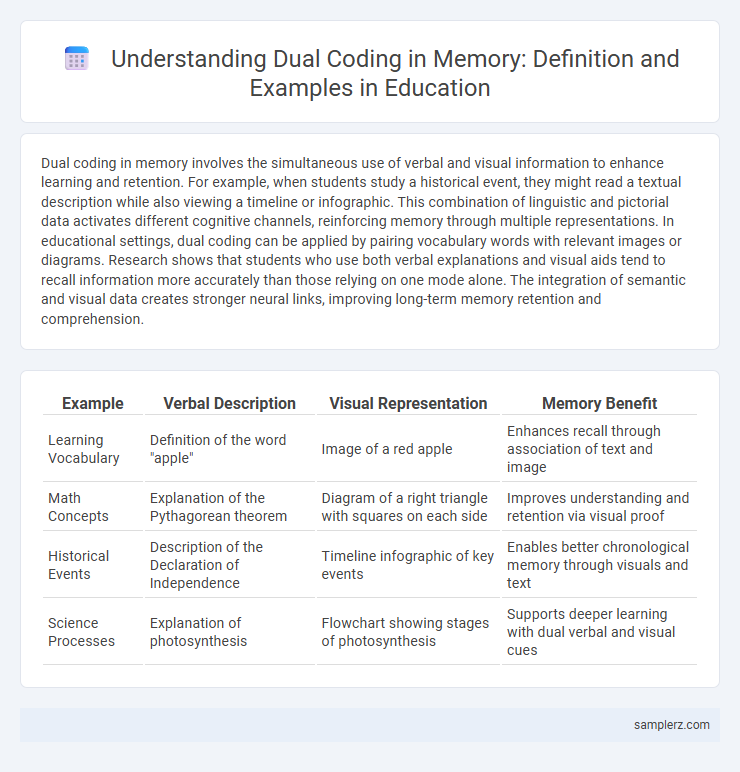Dual coding in memory involves the simultaneous use of verbal and visual information to enhance learning and retention. For example, when students study a historical event, they might read a textual description while also viewing a timeline or infographic. This combination of linguistic and pictorial data activates different cognitive channels, reinforcing memory through multiple representations. In educational settings, dual coding can be applied by pairing vocabulary words with relevant images or diagrams. Research shows that students who use both verbal explanations and visual aids tend to recall information more accurately than those relying on one mode alone. The integration of semantic and visual data creates stronger neural links, improving long-term memory retention and comprehension.
Table of Comparison
| Example | Verbal Description | Visual Representation | Memory Benefit |
|---|---|---|---|
| Learning Vocabulary | Definition of the word "apple" | Image of a red apple | Enhances recall through association of text and image |
| Math Concepts | Explanation of the Pythagorean theorem | Diagram of a right triangle with squares on each side | Improves understanding and retention via visual proof |
| Historical Events | Description of the Declaration of Independence | Timeline infographic of key events | Enables better chronological memory through visuals and text |
| Science Processes | Explanation of photosynthesis | Flowchart showing stages of photosynthesis | Supports deeper learning with dual verbal and visual cues |
Introduction to Dual Coding Theory in Education
Dual coding theory in education involves combining verbal and visual information to enhance memory retention. For example, presenting a diagram alongside a written explanation of the water cycle allows students to process and store information through both linguistic and imagery-based pathways. This approach leverages the brain's dual channels, improving comprehension and recall by creating interconnected memory traces.
Understanding How Dual Coding Enhances Memory
Dual coding enhances memory by combining visual and verbal information, making it easier for the brain to encode and retrieve data. For example, when studying anatomy, students who use labeled diagrams alongside explanatory text show improved recall compared to text-only learning. This method leverages the brain's ability to process images and words through separate channels, strengthening overall comprehension and retention.
Example 1: Using Diagrams and Text in Science Lessons
In science lessons, dual coding strengthens memory retention by combining diagrams with explanatory text to engage both visual and verbal cognitive pathways. For example, a biology class might use labeled diagrams of the human heart alongside detailed textual descriptions to enhance understanding of its functions. This method reduces cognitive load and improves recall by providing complementary information through multiple sensory channels.
Example 2: Combining Audio Narration with Visual Slides
Combining audio narration with visual slides enhances memory retention by engaging both auditory and visual processing channels. Research shows that students exposed to synchronized spoken explanations and corresponding images recall information more effectively than those using text-only materials. This dual coding technique leverages the brain's capacity to integrate verbal and visual information, promoting deeper learning and long-term retention.
Example 3: Integrating Mnemonics with Illustrations
Example 3 of dual coding in memory demonstrates the effectiveness of integrating mnemonics with illustrations, where visual imagery enhances the retention of verbal information. For instance, pairing a mnemonic phrase like "Every Good Boy Deserves Fudge" with a diagram of musical notes on a staff helps learners memorize the order of notes more efficiently. This combination leverages both verbal and visual memory pathways, resulting in improved recall and deeper understanding.
Example 4: Pairing Concept Maps with Written Explanations
Pairing concept maps with written explanations enhances memory retention by engaging both visual and verbal cognitive processes. Concept maps visually organize relationships between key ideas, while written explanations provide detailed context and elaboration. This dual coding approach improves understanding and recall by integrating graphical representation with textual information.
Example 5: Employing Flashcards with Images and Words
Flashcards combining images and words enhance memory retention by activating both visual and verbal processing pathways. Example 5 highlights using a flashcard with a picture of the human heart alongside its labeled parts, facilitating deeper encoding through dual coding. This method significantly improves recall compared to text-only study techniques, leveraging the brain's ability to integrate visual and linguistic information.
Classroom Activities Leveraging Dual Coding for Better Recall
Classroom activities leveraging dual coding, such as combining visual aids with verbal explanations, enhance memory retention by engaging both the visual and auditory processing centers of the brain. For example, students who create mind maps alongside written notes demonstrate improved recall and deeper understanding of complex concepts. Incorporating multimedia presentations that pair images with narrated content further supports dual coding, making learning more effective and durable.
Benefits of Dual Coding Strategies in Student Learning
Dual coding strategies enhance student learning by combining verbal and visual information, which improves memory retention and recall through dual-channel processing. This method reduces cognitive load, enabling more efficient encoding and retrieval of knowledge in subjects like science and language arts. Research shows students using dual coding outperform those relying solely on text, achieving higher comprehension and longer-lasting understanding.
Tips for Educators to Implement Dual Coding Techniques
Using dual coding techniques, educators should combine verbal explanations with relevant visuals such as diagrams or infographics to enhance memory retention. Incorporating multimedia resources like videos alongside text helps engage multiple cognitive channels, strengthening students' understanding. Providing opportunities for students to create their own visual representations of concepts can further reinforce learning through active involvement.

example of dual coding in memory Infographic
 samplerz.com
samplerz.com